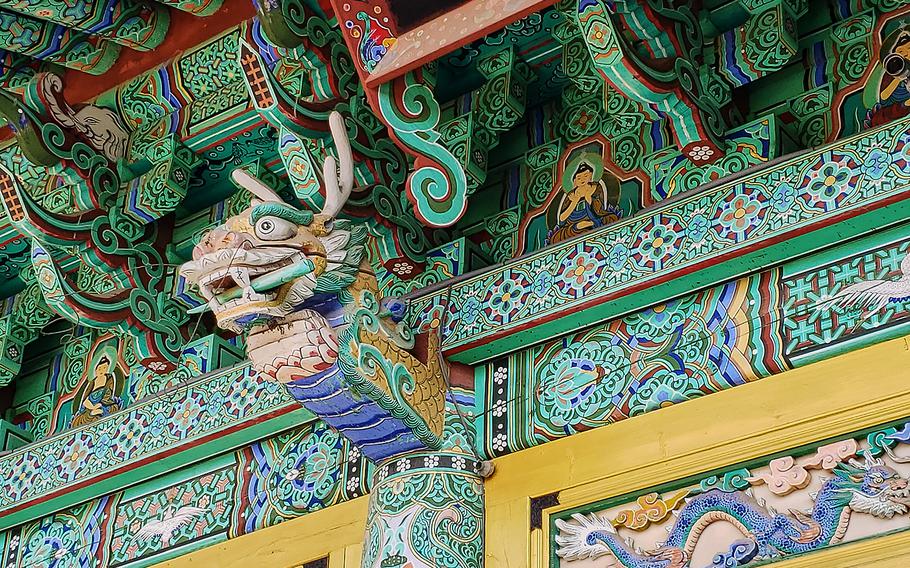
Upon arriving at the entrance of Mangisa Temple, visitors pass through a gate decorated with intricate wooden carvings of dragons. (Matt Keeler/Stars and Stripes)
In South Korea, the demands of daily life and the stress of living in a bustling city often require residents to seek a bit of rest and relaxation. Luckily, a temple compound nestled in the hills of Jinwi, between Osan and Pyeongtaek, provides the perfect location for locals to get in touch with their spiritual side.
Located just 6 miles from Osan Air Base is Mangisa Temple, home to the Iron Seated Buddha, one of South Korea’s national treasures. The country designates national treasures based upon the historical and artistic value of exceptional artifacts or locations — and this extravagant golden statue, said to have been created in the 8th or 9th century, is no exception.
Like the Buddha statue that forms the centerpiece of the temple’s grounds, the Mangisa Temple is said to have been established during Korea’s Goryeo Period sometime around the year 962. These days, the site remains a popular location for practicing Buddhists to make spiritual pilgrimages — but don’t let the temple’s religious roots deter you from visiting.
Upon arriving at the temple entrance, visitors pass through a gate decorated with intricate wooden carvings of dragons. Here, worshippers are expected to leave all problems at the door — literally. Whether plagued by the stresses of work or an impending college entrance exam, pass through the gates of Mangisa Temple and your troubles will (hopefully) vanish into thin air.
Immediately after passing through the temple gate, take note of the colorful statues of the Four Heavenly Kings, Buddhist gods that are said to watch over a different cardinal direction of the world. The Four Heavenly Kings are an essential component of Buddhism and can be found in some form at nearly all Buddhist temples.
A nearby small set of stairs leads into an open courtyard, providing a magnificent view of everything Mangisa Temple has to offer.
At the temple, visitors may enter four buildings of worship, each containing unique artifacts and artwork dating back hundreds, or even thousands, of years. Be sure to wear clean socks, as removing one’s shoes is a requirement before entering any of these structures.
Although photography is permitted inside, the temple asks that visitors refrain from taking photos while worshippers are paying their respects to the Buddha.
Daeungjeon Hall is where visitors can find the Iron Seated Buddha of Mangisa Temple. When entering the hall, followers of the faith will respectfully bow several times to the Buddha. Some bring offerings of fresh fruits and vegetables to place at the statue’s feet.
Hundreds of colorful lanterns and banners hang from the roof of the hall, and for a small fee, worshippers can have the name of a loved one inscribed upon one of these banners to ask for prayers and good fortune.
On Sunday, May 12, the temple celebrates Buddha’s birthday by hosting a lively celebration complete with decorations, food and other festivities.
If you make plans to visit Mangisa Temple on a weekend, it might be best to come hungry, as the temple groundskeepers prepare an elaborate meal consisting of a variety of traditional Korean dishes. In keeping with Buddhist tradition, the meal is prepared without the use of animal products, making this a unique dining experience for vegans and vegetarians alike. Taking part in the meal, which is served at noon, is free — but donations are gladly accepted at deposit boxes located near the Four Heavenly Kings.
There’s more to Mangisa Temple than religious artifacts. The grounds also offer some spectacular hiking opportunities on several trails that wind through the hills of Jinwi. The trails are easy to identify, and some portions have ropes for hikers to grab onto for extra stability. The route I took during my visit clocked in at just over 3.5 miles from start to finish, according to my fitness tracker.
The summit is easy to identify, thanks to a large South Korean flag. There’s also an observation deck with binoculars providing a magnificent view of the city below. It’s an ideal spot for a quick snack or a brief rest before descending the hills back to the temple.
Mangisa Temple is one of the few places in the Pyeongtaek area that brings residents out of the city and closer to nature. Whether you’re seeking to explore Korea’s past, to find a bit of serenity on an enjoyable hike, or simply looking to visit someplace new, this peaceful compound is a great way to leave the troubles of your 21st century lifestyle behind — if only for an afternoon.
MANGISA TEMPLELOCATION: 181-82 Jinwi-ro, Jinwi-myeon, PyeongtaekDIRECTIONS: Mangisa Temple is reachable by public transportation via the Seoul Subway Line 1 at Jinwi Station. The temple gate is roughly 3 km from the station, and taxis are readily available. By car from Osan Air Base, the temple is a short drive away along Jisan-ro to Route 317.HOURS: While there are no official operating hours, visitation is recommended between 9:00 a.m. and 5:00 p.m.COSTS: Visiting the temple is free, but donations are appreciated.FOOD: On weekends, temple staff serves a vegan lunch comprised of traditional Korean dishes. The meal is free, but donations are encouraged.INFORMATION: 031-664-7336